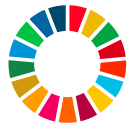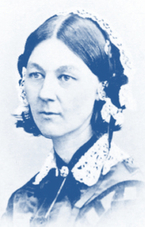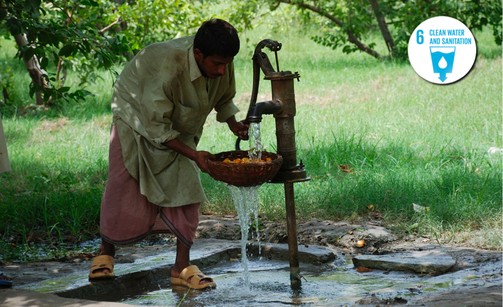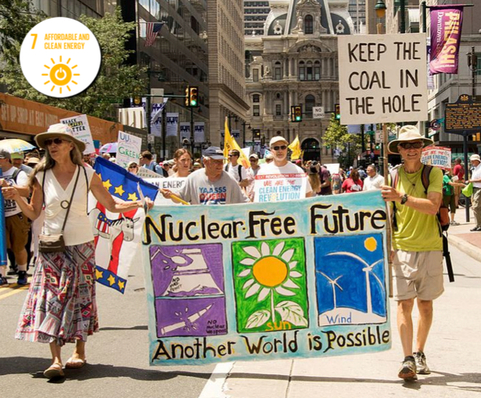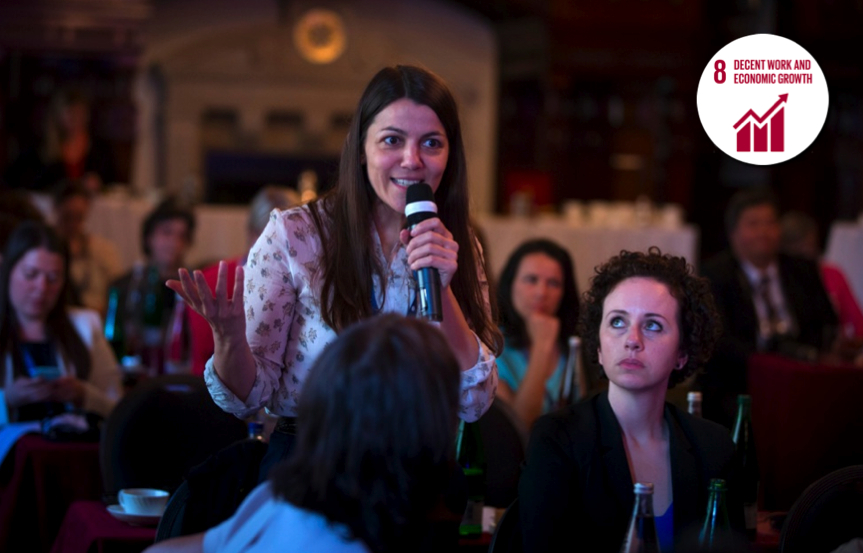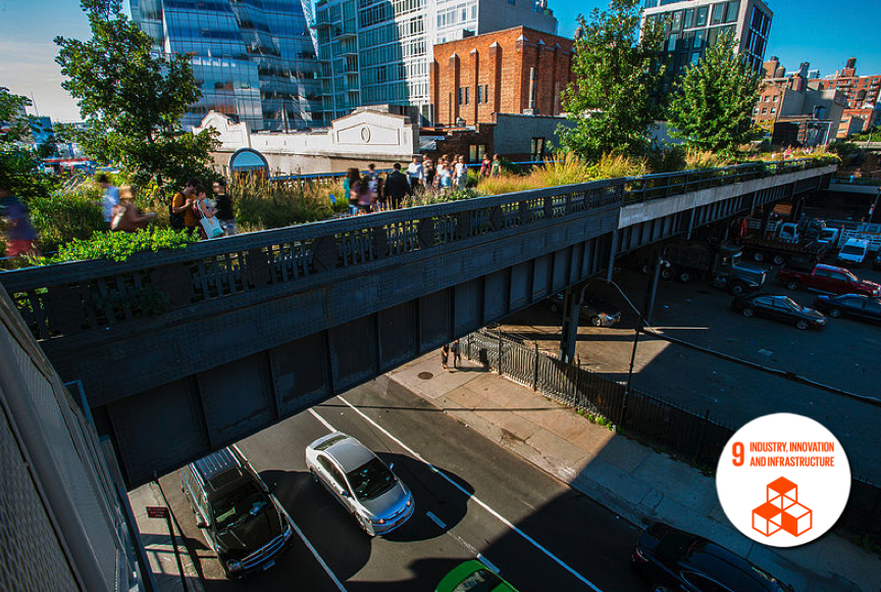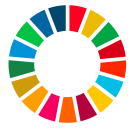|
Photo Sources: Above Left: Official UN SDG Color Wheel. Above Right: Photo of Florence Nightingale, in the public domain. Above Center: Wikimedia, 2007, Photographer: 'Mo' in Pakistan. Used with the Creative Commons Attribution Share-Alike 2.0 Generic license. SDG Logo # 6 posted using the official UN SDG Guidelines.
|
|
|
Although Nightingale did not specifically anticipate SDG # 7 — Renewable Energy — to “ensure access to affordable, reliable, sustainable and clean energy for all,” she often called for observing and following the ‘laws of nature’ and using these ‘laws’ to improve the quality of life. “In dwelling upon the vital importance of sound observation, it must never be lost sight of what observation is for. It is not for the sake of piling up miscellaneous information or curious facts, but for the sake of saving life and increasing health and comfort.” (1860) It is also interesting to note that she used an energy-related metaphor in one of her most famous quotes, “Health is not only to be well, but to use well, every power we have.” (1893) .
|
Photo Source: Wikimedia & The March for a Clean Energy Revolution Philadelphia, 25 July 2016. Author: Becker from Grove City, Ohio.
This file is licensed under the Creative Commons Attribution 2.0. SDG Logo # 7 posted using the official UN SDG Guidelines.
This file is licensed under the Creative Commons Attribution 2.0. SDG Logo # 7 posted using the official UN SDG Guidelines.
|
Photo Source: Wikimedia & Empowering Women for Economic Growth: The Smart Choice for the G20, July 11-12, 2016, at One Whitehall Place, London. © Suzanne Plunkett 2016, using the Creative Commons Attribution 2.0 Generic license. SDG Logo # 8 posted using the official UN SDG Guidelines.
Throughout her own career, Nightingale embraced innovation and saw the value of innovation. She noted, “if we can transform by a few years of quiet, the habits of centuries, or progress will have been slow, but amazing rapid.” (1894) She would have appreciated SDG # 9 — Innovation & Infrastructure — to “build resilient infrastructure, promote inclusive and sustainable industrialization and foster innovation.” She even help to develop improved infrastructure in her own time and was responsible for the innovative design of the original St Thomas’ Hospital — some of which is still standing on the banks of the river Thames in London. Her innovations included setting windows in such a way as to allowed sunlight to be readily available to patients and the nurses caring for them.
The above featured picture illustrates the infrastructure innovation called for by SDG # 9. 'High Line' is an elevated old railway line owned by the City of New York. Today it is a 1.45-mile-long linear public park maintained, operated, and programmed by Friends of the High Line, in partnership with the New York City Department of Parks & Recreation. The High Line railway line was opened in 1934 and moved goods to and from Manhattan’s largest industrial district until 1980. The new HIGH Line was launched on September 15, 2015.
Now, the High Line's green roof system, with drip irrigation, is designed to allow the planting beds to retain as much water as possible. Because many of the plants are drought-tolerant, they need little supplemental watering. When supplemental watering is needed, hand watering is used so as to tailor the amount of water to the needs of individual species and weather conditions, and to conserve water.
High Line is independently funded from U.S. Department of Agriculture (USDA) Forest Service (USFS). Urban forestry and green spaces are priority areas for USFS. With 80 percent of the nation's population in urban areas, there are strong environmental, social, and economic cases to be made for the conservation of green spaces to guide growth and revitalize city centers and older suburbs. Urban forests broadly include urban parks, street trees, landscaped boulevards, public gardens, river and coastal promenades, greenways, river corridors, wetlands, nature preserves, natural areas, shelter belts of trees and working trees at industrial brownfield sites.
Urban forests are dynamic ecosystems that provide needed environmental services by cleaning air and water helping to control storm water, and conserving energy. They add form, structure, beauty and breathing room to urban design, reduce noise, separate incompatible uses, provide places to recreate, strengthen social cohesion, leverage community revitalization, and add economic value to our communities. Urban forests — through planned connections of green spaces — form the green infrastructure system on which communities depend. Green infrastructure works at multiple scales from the neighborhood to the metro area up to the regional landscape.
This natural life support system sustains clean air and water, biodiversity, habitat, nesting and travel corridors for wildlife, and connects people to nature. Urban forests, through planned connections of green spaces, form the green infrastructure system on which communities depend. Urban and Community Forestry (UCF) is a cooperative program of the US Forest Service that focuses on the stewardship of urban natural resources. UCF provides technical, financial, research and educational services to local government, non-profit organizations community groups, educational institutions, and tribal governments. The program is delivered through its legislative partners, the state forestry agencies in 59 states and US territories.
Forest Service cooperative programs are currently being redesigned to make more effective use of federal resources. Programs will be focused on issues and landscapes of national importance and prioritized through state and regional assessments. Over the next five years, an increasing percentage of funding will be focused on landscape scale projects. Three national themes provide a framework for this work: conserve working forest landscapes; protect forests from harm; and enhance benefits associated with trees and forests.
Photo Source: Wikipedia, USDA Photo By Lance Cheung. This file is licensed under the Creatie Commons Attribution 2.0 Generic license.
SDG Logo # 9 posted using the official UN SDG Guidelines.
Now, the High Line's green roof system, with drip irrigation, is designed to allow the planting beds to retain as much water as possible. Because many of the plants are drought-tolerant, they need little supplemental watering. When supplemental watering is needed, hand watering is used so as to tailor the amount of water to the needs of individual species and weather conditions, and to conserve water.
High Line is independently funded from U.S. Department of Agriculture (USDA) Forest Service (USFS). Urban forestry and green spaces are priority areas for USFS. With 80 percent of the nation's population in urban areas, there are strong environmental, social, and economic cases to be made for the conservation of green spaces to guide growth and revitalize city centers and older suburbs. Urban forests broadly include urban parks, street trees, landscaped boulevards, public gardens, river and coastal promenades, greenways, river corridors, wetlands, nature preserves, natural areas, shelter belts of trees and working trees at industrial brownfield sites.
Urban forests are dynamic ecosystems that provide needed environmental services by cleaning air and water helping to control storm water, and conserving energy. They add form, structure, beauty and breathing room to urban design, reduce noise, separate incompatible uses, provide places to recreate, strengthen social cohesion, leverage community revitalization, and add economic value to our communities. Urban forests — through planned connections of green spaces — form the green infrastructure system on which communities depend. Green infrastructure works at multiple scales from the neighborhood to the metro area up to the regional landscape.
This natural life support system sustains clean air and water, biodiversity, habitat, nesting and travel corridors for wildlife, and connects people to nature. Urban forests, through planned connections of green spaces, form the green infrastructure system on which communities depend. Urban and Community Forestry (UCF) is a cooperative program of the US Forest Service that focuses on the stewardship of urban natural resources. UCF provides technical, financial, research and educational services to local government, non-profit organizations community groups, educational institutions, and tribal governments. The program is delivered through its legislative partners, the state forestry agencies in 59 states and US territories.
Forest Service cooperative programs are currently being redesigned to make more effective use of federal resources. Programs will be focused on issues and landscapes of national importance and prioritized through state and regional assessments. Over the next five years, an increasing percentage of funding will be focused on landscape scale projects. Three national themes provide a framework for this work: conserve working forest landscapes; protect forests from harm; and enhance benefits associated with trees and forests.
Photo Source: Wikipedia, USDA Photo By Lance Cheung. This file is licensed under the Creatie Commons Attribution 2.0 Generic license.
SDG Logo # 9 posted using the official UN SDG Guidelines.
Image Credits, above left: the UN Logo Color wheel used based on official UN SDG Guidelines.
Above right: the face of Florence Nightingale is a photograph in the public domain.
